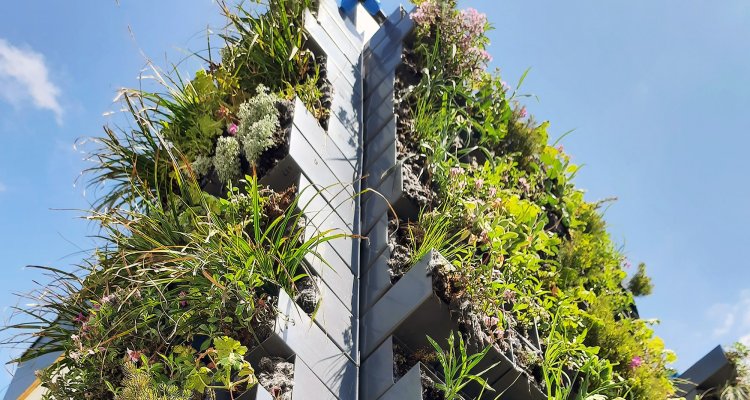
News
Green walls flourish at Dutch Design Week
As in previous years, Wageningen University & Research (WUR) contributes to the renowned Dutch Design Week in Eindhoven. One of the inspirational designs from Wageningen is Plant Pixel, a green wall design for buildings by PhD candidate Maricruz Solera Jimenez.
Solera Jimenez created Plant Pixel as part of her PhD at the Landscape Architecture and Spatial Planning cluster. It consists of cubes of various shapes and sizes that contain different kinds of plants. These can be attached to the walls of buildings to create a green façade in urban areas. ‘The cubes can be plugged into each other, almost like Lego’, explains Solera Jimenez. They do not contain soil, which would be too heavy. Instead, recycled clothing is used as substrate. Water is pumped through drippers, which go from one cube to the next.
- Unfortunately, your cookie settings do not allow videos to be displayed. - check your settings
For her research, Solera Jimenez combined WUR’s expertise in the field of research methodology with practical work in the industry. In the south of Germany, she worked at the green roof company Zinco for two years. There, she constructed a prototype that includes 500 plants in 500 cubes and is attached to a 2.5-metre wall. ‘The project’s goal is to find cost-effective, low-carbon innovations that are part of a circular framework. And I also wanted the design to be fun and interesting.’
The prototype turned out to work wonderfully. ‘We tried 22 plant species, all of which did very well. They didn’t require a lot of maintenance either, just some trimming once a year.’ The prototype also showed that it can help reduce summer temperatures, one of the many benefits of green façade systems. Solera Jimenez installed devices up to 40 centimetres from the wall to measure climate effects. The results showed that the green wall was cooling the temperature by 2 to 3 degrees.
Inspired by green rock walls
‘Nature has the most beautiful green walls!’, Solera Jimenez exlaims. ‘Our design was inspired by steep rock walls, where many different plants are able to thrive.’ To analyse how plants manage to survive there, she ventured to the Breitachklamm, a gorge in the south of Germany. ‘Our cubes try to mimic those rocks. They are at a 15 degree angle, so that there is enough water to keep the roots moist. And the cubes come in different sizes, because steep rock walls are not straight either.’
Designing the future
At the Dutch Design Week, Solera Jimenez has a unique opportunity to display her work to the audience. Her exhibition is part of Design United, a collaboration between the four technical universities in the Netherlands (4TU). The Dutch Design Week attracts hundreds of thousands of visitors each year, including representatives from companies and municipalities, as well as students and families.
For Solera Jimenez, the event has been a very gratifying experience. ‘Being there has really changed my perspective. As a researcher, I’m used to looking at my design critically, so it’s very nice when people come over to find out more.’ Multiple visitors even wanted to apply Plant Pixel to their own house. ‘I really love it when people are interested in my design. I have to tell them that they can’t buy the system, since this is only a prototype. But it’s not that difficult to make. I’ll gladly explain how people can create it themselves.’